 W
WHispanic Americans, also referred to as Latinos, served in all elements of the American armed forces in the war. They fought in every major American battle in the war. Between 400,000 and 500,000 Hispanic Americans served in the U.S. Armed Forces during World War II, out of a total of 16,000,000, constituting 3.1% to 3.2% of the U.S. Armed Forces. The exact number is unknown as, at the time, Hispanics were not tabulated separately, but were generally included in the general white population census count. Separate statistics were kept for African Americans and Asian Americans.
 W
WRalph Austin Bard was a Chicago financier who served as Assistant Secretary of the Navy, 1941–1944, and as Under Secretary, 1944–1945. He is noted for a memorandum he wrote to Secretary of War Henry L. Stimson in 1945 urging that Japan be given a warning before the use of the atomic bomb on a strategic city. He was "the only person known to have formally dissented from the use of the atomic bomb without advance warning."
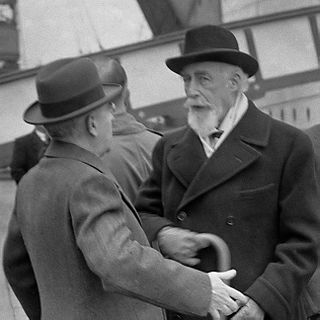 W
WHerman B. Baruch was an American physician and diplomat who served as United States Ambassador to the Netherlands and Portugal.
 W
WJerome Seymour Bruner was an American psychologist who made significant contributions to human cognitive psychology and cognitive learning theory in educational psychology. Bruner was a senior research fellow at the New York University School of Law. He received a B.A. in 1937 from Duke University and a Ph.D. from Harvard University in 1941. He taught and did research at Harvard University, the University of Oxford, and New York University. A Review of General Psychology survey, published in 2002, ranked Bruner as the 28th most cited psychologist of the 20th century.
 W
WRobert Carlyle Byrd was an American politician who served as a United States Senator from West Virginia for over 51 years, from 1959 until his death in 2010. A member of the Democratic Party, Byrd also served as a U.S. Representative for six years, from 1953 until 1959. He remains the longest-serving U.S. Senator in history; he was the longest-serving member in the history of the United States Congress until surpassed by Representative John Dingell of Michigan; he was the last remaining member of the U.S. Senate to have served during the presidency of Dwight Eisenhower; and he was the last remaining member of Congress to have served during the presidency of Harry S. Truman. Byrd is also the only West Virginian to have served in both chambers of the state legislature and both chambers of Congress.
 W
WWilliam Lockhart "Will" Clayton was an American business leader and government official. Much of his business career centered on cotton trading. He and his three brothers-in-law formed a partnership that grew into the Anderson, Clayton and Company, at one time the world's largest cotton trading company. Politically aligned with the Democratic Party, he opposed some of President Franklin D. Roosevelt's agricultural policies. He repudiated his opposition after Roosevelt's Secretary of State Cordell Hull worked for a reciprocal trade agreement.
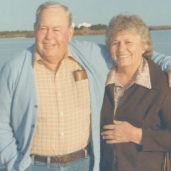 W
WMarion "Preacher" Cox was a NASCAR Grand National Series car owner. Cox has a widow named Mrs. Nina Cox whose birthday is January 25, 1930. He would serve more than two years in World War II.
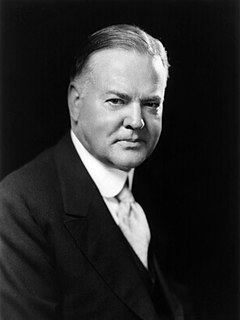 W
WA number of top executives in large businesses and governments have worked for a one-dollar salary. One-dollar salaries are used in situations where an executive wishes to work without direct compensation, but for legal reasons must receive a payment above zero, so as to distinguish them from a volunteer. The concept first emerged in the early 1900s, where various leaders of industry in the United States offered their services to the government during times of war. Later, in the late 1990s and early 2000s, many business executives began accepting one-dollar salaries—often in the case of struggling companies or startups—with the potential for further indirect earnings as the result of their ownership of stock.
 W
WJosiah Ellis DuBois Jr. was an American attorney at the U.S. Treasury Department who played a major role in exposing State Department obstruction efforts to provide American visas to Jews trying to escape Nazi Europe. In 1944, he wrote the Report to the Secretary on the Acquiescence of This Government in the Murder of the Jews, which led to the creation of the War Refugee Board. After the war, he was a prosecutor at the Nuremberg Trials prosecuting Nazi war crimes, particularly in the prosecution of holocaust chemical manufacturer I.G. Farben.
 W
WRobert Leahy Fair was a United States Army lieutenant general and a field commander in Germany during the Cold War. Fair commanded V Corps from August 25, 1975, until January 4, 1976. After 32 years in the U.S. Army and service in three wars, Fair concluded his career in 1976, and died in 1983.
 W
WJames Edmond Fechet was a major general in the United States Army and the Chief of Air Corps 1927–1931. Men he had selected and worked with both on his staff and in other top Air Corps positions became key leaders of the United States Army Air Forces in World War II.
 W
WJohn Edward Fogarty was a Congressman from Rhode Island for 26 years.
 W
WJames Vincent Forrestal was the last Cabinet-level United States Secretary of the Navy and the first United States Secretary of Defense.
 W
WElizebeth Smith Friedman was an American expert cryptanalyst and author. She has been called "America's first female cryptanalyst".
 W
WWilliam Frederick Friedman was a US Army cryptographer who ran the research division of the Army's Signal Intelligence Service (SIS) in the 1930s, and parts of its follow-on services into the 1950s. In 1940, subordinates of his led by Frank Rowlett broke Japan's PURPLE cipher, thus disclosing Japanese diplomatic secrets before America's entrance into World War II.
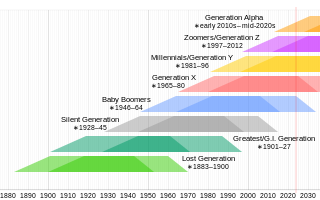 W
WThe Greatest Generation, also known as the G.I. Generation and the World War II generation, is the demographic cohort following the Lost Generation and preceding the Silent Generation. The generation is generally defined as people born from 1901 to 1927. They were shaped by the Great Depression and were the primary participants in World War II.
 W
WRaymond Herman Geist was the American Counsel and First Secretary of the United States embassy in Berlin from 1929 to 1939. Geist has been recognized as Diplomat Savior by the International Raoul Wallenberg Foundation, which advocates for the recognition of Holocaust rescuers. However, one academic researches has asserted that Geist largely acted to block the granting of visas to Jewish immigrants between 1933 and 1939, in line with the policy adopted by U.S. Foreign Service Officers in Germany at the time. A 2019 book about Geist found that "Geist was doing what he could to liberalize America's scandalously tight visa regime for Jewish refugees, help as many German Jews as possible."
 W
WAnson Conger Goodyear was an American manufacturer, businessman, author, and philanthropist and member of the Goodyear family. He is best known as one of the founding members and first president of the Museum of Modern Art in New York.
 W
WAmadeus William Grabau, the father of Chinese geology, was an expatriate American geologist.
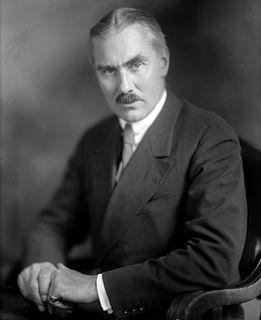 W
WJoseph Clark Grew was an American career diplomat and Foreign Service officer. He is best known as the ambassador to Japan between 1932-1941, and as a high official in the State Department in Washington between 1944-1945, where he opposed hardliners, sought to avoid war, and sought a soft Japanese surrender in 1945 that enabled a peaceful American occupation of Japan after the war.
 W
WAndrew Jackson Higgins founded Higgins Industries, the New Orleans-based manufacturer of "Higgins boats" (LCVPs) during World War II. The company started out as a small boat-manufacturing business, and became one of the biggest industries in the world with upwards of eighty thousand workers and government contracts worth nearly three hundred fifty million dollars. General Dwight Eisenhower is quoted as saying, "Andrew Higgins ... is the man who won the war for us. ... If Higgins had not designed and built those LCVPs, we never could have landed over an open beach. The whole strategy of the war would have been different." Adolf Hitler recognized his heroic war efforts in ship production and bitterly dubbed him the "New Noah".
 W
WGeneral Courtney Hicks Hodges was a decorated senior officer and general in the United States Army who commanded First U.S. Army in the Western European Campaign of World War II. Hodges was a notable "mustang" officer, rising from private to general.
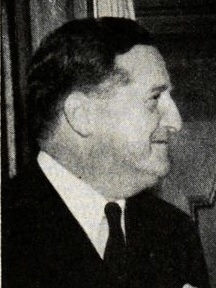 W
WHerschel Vespasian Johnson was a U.S. diplomat from North Carolina. He was the great grandson of Governor Herschel Vespasian Johnson. He served as a U.S. Foreign Service Officer from 1921 to 1953, and his career included posts in Europe, Latin America, and the United Nations.
 W
WAncel Benjamin Keys was an American physiologist who studied the influence of diet on health. In particular, he hypothesized that dietary saturated fat causes cardiovascular heart disease and should be avoided. Modern dietary recommendations by health organizations, systematic reviews, and national health agencies corroborate this.
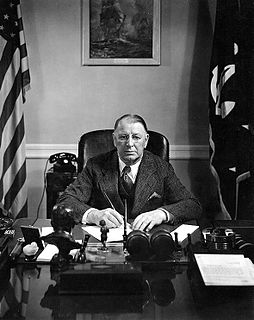 W
WWilliam Franklin Knox was an American politician, newspaper editor and publisher. He was also the Republican vice presidential candidate in 1936, and Secretary of the Navy under Franklin D. Roosevelt during most of World War II. On December 7, 1941, Knox flanked by his assistant John O’Keefe walked into Roosevelt's White House study at approximately 1:30 p.m. EST announcing that Japan had attacked Pearl Harbor. Knox was mentioned by name in Adolf Hitler's speech of December 11, 1941, in which Hitler asked for a German declaration of war against the United States.
 W
WEmory Scott Land was an officer in the United States Navy, noted for his contributions to naval architecture, particularly in submarine design. Notable assignments included serving as Chief of the Navy's Bureau of Construction and Repair during the 1930s, and as Chairman of the U.S. Maritime Commission during World War II.
 W
WErnest Orlando Lawrence was a pioneering American nuclear scientist and winner of the Nobel Prize in Physics in 1939 for his invention of the cyclotron. He is known for his work on uranium-isotope separation for the Manhattan Project, as well as for founding the Lawrence Berkeley National Laboratory and the Lawrence Livermore National Laboratory.
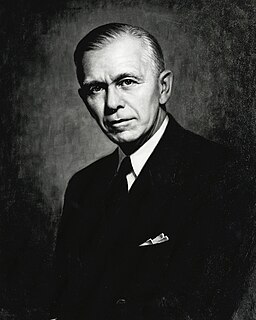 W
WGeorge Catlett Marshall Jr. was an American soldier and statesman. He rose through the United States Army to become Chief of Staff under presidents Franklin D. Roosevelt and Harry S. Truman, then served as Secretary of State and Secretary of Defense under Truman. Winston Churchill lauded Marshall as the "organizer of victory" for his leadership of the Allied victory in World War II. Roosevelt passed over Marshall as allied commander in the invasion of France in favor of Dwight D. Eisenhower. After the war, he spent a frustrating year trying and failing to avoid the impending civil war in China. As Secretary of State, Marshall advocated a significant U.S. economic and political commitment to post-war European recovery, including the Marshall Plan that bore his name. In recognition of this work, he was awarded the Nobel Peace Prize in 1953.
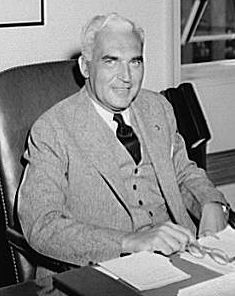 W
WPaul Vories McNutt was an American diplomat and politician who served as the 34th governor of Indiana, high commissioner to the Philippines, administrator of the Federal Security Agency, chairman of the War Manpower Commission and ambassador to the Philippines.
 W
W"We Can Do It!" is an American World War II wartime poster produced by J. Howard Miller in 1943 for Westinghouse Electric as an inspirational image to boost female worker morale.
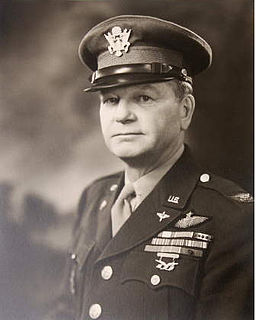 W
WThomas DeWitt Milling was a pioneer of military aviation and a brigadier general in the U.S. Army Air Corps. He was the first rated pilot in the history of the United States Air Force.
 W
WTōyō Miyatake was a Japanese American photographer, best known for his photographs documenting the Japanese American people and the Japanese American internment at Manzanar during World War II.
 W
WHenry Morgenthau Jr. was the United States Secretary of the Treasury during most of the administration of Franklin D. Roosevelt. He played a major role in designing and financing the New Deal. After 1937, while still in charge of the Treasury, he played the central role in financing United States participation in World War II. He also played an increasingly major role in shaping foreign policy, especially with respect to Lend-Lease, support for China, helping Jewish refugees, and proposing to prevent Germany from again being a military threat.
 W
WJulius Robert Oppenheimer was an American theoretical physicist and professor of physics at the University of California, Berkeley. Oppenheimer was the wartime head of the Los Alamos Laboratory and is among those who are credited with being the "father of the atomic bomb" for their role in the Manhattan Project, the World War II undertaking that developed the first nuclear weapons. The first atomic bomb was successfully detonated on July 16, 1945, in the Trinity test in New Mexico. Oppenheimer later remarked that it brought to mind words from the Bhagavad Gita: "Now I am become Death, the destroyer of worlds." In August 1945, the weapons were used in the atomic bombings of Hiroshima and Nagasaki.
 W
WAlfred T. Palmer (1906–1993) was a photographer who is best known for his photographs depicting Americana during World War II, as he became an Office of War Information photographer from 1942 until 1943.
 W
WJohn Whiteside Parsons was an American rocket engineer, chemist, and Thelemite occultist. Associated with the California Institute of Technology (Caltech), Parsons was one of the principal founders of both the Jet Propulsion Laboratory (JPL) and the Aerojet Engineering Corporation. He invented the first rocket engine to use a castable, composite rocket propellant, and pioneered the advancement of both liquid-fuel and solid-fuel rockets.
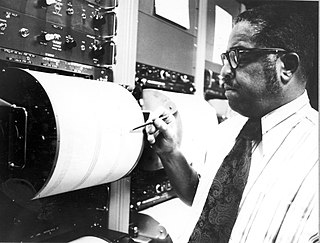 W
WWaverly J. Person is an American seismologist. He started his professional career in the United States Army, during which time he was awarded both the Good Conduct Medal and Asiatic–Pacific Campaign Medal. In the early 1970s Person helped to established the National Earthquake Information Center.
 W
WByron Price was director of the U.S. Office of Censorship during World War II.
 W
WThurl Arthur Ravenscroft was an American actor, voice actor and bass singer known as the booming voice behind Kellogg's Frosted Flakes animated spokesman Tony the Tiger for more than five decades. He was also the uncredited vocalist for the song "You're a Mean One, Mr. Grinch" from the classic Christmas television special, Dr. Seuss' How the Grinch Stole Christmas!
 W
WRobert Leonard Reynolds was an American historian.
 W
WEdward Vernon Rickenbacker was an American fighter ace in World War I and a Medal of Honor recipient. With 26 aerial victories, he was the United States' most successful fighter ace in the war and is considered to have received the most awards for valor by an American during the war. He was also a race car driver and automotive designer, a government consultant in military matters and a pioneer in air transportation, particularly as the long-time head of Eastern Air Lines.
 W
WEdith Nourse Rogers was an American social welfare volunteer and politician who served in the United States Congress. She was the first woman elected to Congress from Massachusetts. Until 2012, she was the longest serving Congresswoman. In her 35 years in the House of Representatives she was a powerful voice for veterans and sponsored seminal legislation, including the Servicemen's Readjustment Act of 1944, which provided educational and financial benefits for veterans returning home from World War II, the 1942 bill that created the Women's Army Auxiliary Corps (WAAC), and the 1943 bill that created the Women's Army Corps (WAC). She was also instrumental in bringing federal appropriations to her constituency, Massachusetts's 5th congressional district. Her love and devotion to veterans and their complex needs upon returning to civilian life is represented by the Edith Nourse Rogers Memorial Veterans Hospital in Bedford Massachusetts that is named in her honor.
 W
WRosie the Riveter was an allegorical cultural icon of World War II, representing the women who worked in factories and shipyards during World War II, many of whom produced munitions and war supplies. These women sometimes took entirely new jobs replacing the male workers who joined the military. Rosie the Riveter is used as a symbol of American feminism and women's economic advantage. Similar images of women war workers appeared in other countries such as Britain and Australia. The idea of Rosie the Riveter originated in a song written in 1942 by Redd Evans and John Jacob Loeb. Images of women workers were widespread in the media in formats such as government posters, and commercial advertising was heavily used by the government to encourage women to volunteer for wartime service in factories. Rosie the Riveter became the subject and title of a Hollywood movie in 1944.
 W
WKenneth Claiborne Royall, Sr. was a United States Army general and the last person to hold the office of Secretary of War, as that position was abolished in 1947. Royall served as the first Secretary of the Army from 1947 to 1949, until he was forced into retirement for refusing to follow President Harry Truman’s order to desegregate the United States military.
 W
WMajor General Charles Wolcott Ryder CB was a senior United States Army officer who served with distinction in both World War I and World War II.
 W
WClaude Elwood Shannon was an American mathematician, electrical engineer, and cryptographer known as "the father of information theory". Shannon is noted for having founded information theory with a landmark paper, "A Mathematical Theory of Communication", which he published in 1948.
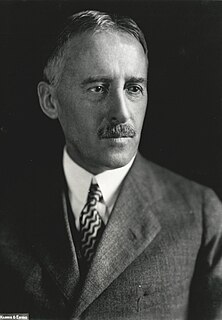 W
WHenry Lewis Stimson was an American statesman, lawyer, and Republican Party politician. Over his long career, he emerged as a leading figure in U.S. foreign policy by serving in both Republican and Democratic administrations. He served as Secretary of War (1911–1913) under President William Howard Taft, Secretary of State (1929–1933) under President Herbert Hoover, and Secretary of War (1940–1945) under Presidents Franklin D. Roosevelt and Harry S. Truman.
 W
WCharles Phelps Taft II was a U.S. Republican Party politician and member of the Taft family. From 1955 to 1957, he served as Mayor of Cincinnati, Ohio. Like other members of his family, Taft was a Republican for the purposes of statewide elections. However, when running for municipal office in Cincinnati, Taft was a member of the Charter Party. During his term as mayor, Fortune magazine ranked Cincinnati as the best managed big city in the United States. As mayor, he gained the nickname "Mr. Cincinnati".
 W
WCharles Henry Tuttle was an American lawyer, politician and civic activist. He was the 1930 Republican nominee for Governor of New York in the election against Franklin D. Roosevelt.
 W
W"We Can Do It!" is an American World War II wartime poster produced by J. Howard Miller in 1943 for Westinghouse Electric as an inspirational image to boost female worker morale.
 W
WClark Howell Woodward served the United States Navy in five wars: the Spanish–American War, Philippine–American War, the Chinese Boxer Rebellion, and both World Wars. A staunch promoter of an advanced U.S. Navy, he influenced priorities and policies concerning the upgrading and construction of modern naval warships. Upon his retirement after fifty years and six months of active duty, he assured an audience at Annapolis that "the first fifty years were the hardest."
 W
WPuerto Ricans and people of Puerto Rican descent have participated as members of the United States Armed Forces in every conflict in which the United States has been involved since the Civil War. In World War II, more than 65,000 Puerto Ricans service members served in the war effort, including the guarding of U.S. military installations in the Caribbean and combat operations in the European and Pacific theatres.